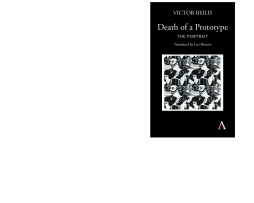
Additional Information
Book Details
Abstract
This is the first work by Victor Beilis to make it into English since the single-volume publication in 2002 of a duo of novellas—“The Rehabilitation of Freud & Bakhtin and Others”(translated by Richard Grose). Much like the novellas that preceded it, “Death of a Prototype” is a hyper-allusive and self-consciously difficult work. Beilis engages closely with an entire spectrum of Russian and European cultural traditions, from classical antiquity to twentieth-century postmodernism. Structurally heterogeneous and fragmented with styles, genres and narrators succeeding one another at great speed, “Death of a Prototype” is also highly balanced and controlled, in some ways recalling a contrapuntal musical composition abounding in thematic echoes and correspondences. “Death of a Prototype” simultaneously challenges and rewards the reader, especially one attuned to fine-grain detail.
Victor Beilis is a scholar of African folklore and author of numerous short stories and one novel.
Leo Shtutin is a translator of literary fiction from Russian.
“Death of a Prototype” is the first work by Victor Beilis to make it into English since the single-volume publication in 2002 of a duo of novellas—“The Rehabilitation of Freud & Bakhtin and Others”( translated by Richard Grose). Much like the novellas that preceded it, “Death of a Prototype” is a hyper-allusive and self-consciously ‘difficult’ work: Beilis delights in intertextual play, inviting the reader to unravel a complex web of quotations, references and paraphrases. The author engages closely with an entire spectrum of Russian and European cultural traditions, from classical antiquity to twentieth-century postmodernism. The visual arts unsurprisingly play a particularly important role in the novel. So, too, is visuality in general: seeing and being seen, acts of perception and observation, gazing, glancing and glimpsing. The reader is confronted with an intimidating array of literary styles, all jostling against one another. Alongside several dialogue-heavy chapters—not all that different stylistically from much contemporary fiction—readers encounter poetic, archaicized prose, self-referential literary analysis, Joycean stream of consciousness, among others.
Table of Contents
| Section Title | Page | Action | Price |
|---|---|---|---|
| Cover | Cover 1 | ||
| Front Matter | i | ||
| Half-title | i | ||
| Title page | iii | ||
| Copyright information | iv | ||
| Table of contents | v | ||
| Acknowledgements | vii | ||
| Translator's introduction | ix | ||
| Part (1-3) | 1 | ||
| Part One | 1 | ||
| Notice | 3 | ||
| Koretsky | 7 | ||
| Adeles Major and Minor | 17 | ||
| Kiryushin | 21 | ||
| The Portrait | 27 | ||
| Korzunov | 31 | ||
| The Portrait \r(Continued) | 39 | ||
| Kazarnovsky | 41 | ||
| The Portrait\r(Continued) | 45 | ||
| Kiryushin | 47 | ||
| The Portrait\r(Continued) | 51 | ||
| Edward | 53 | ||
| The Portrait\r(Conclusion) | 57 | ||
| The Artist | 61 | ||
| Part Two | 71 | ||
| Notice | 73 | ||
| Adele | 81 | ||
| Ada | 83 | ||
| The Portrait\r(Abelone) | 93 | ||
| Yadya | 97 | ||
| The Portrait\r(Eros) | 103 | ||
| Kozin\r(Symphonie fantastique, Fifth Movement) | 111 | ||
| The Portrait\r(Big Brother) | 121 | ||
| The Artist | 139 | ||
| Part Three | 149 | ||
| Notice | 151 | ||
| First and Second | 153 | ||
| Commentary | 157 | ||
| The Letters | 161 | ||
| 1. Little one | 161 | ||
| 2. Madman! | 163 | ||
| 3. Dear … | 164 | ||
| 4. O, Delia … | 168 | ||
| 5. Unaddressed | 170 | ||
| 6. Dearest artist | 171 | ||
| 7. Beloved | 172 | ||
| Notes | 175 | ||
| End Matter | 183 | ||
| Appendix: The Portrait (1873) | 183 | ||
| Translator's Afterword | 205 | ||
| Explanatory Glosses and References | 217 |
